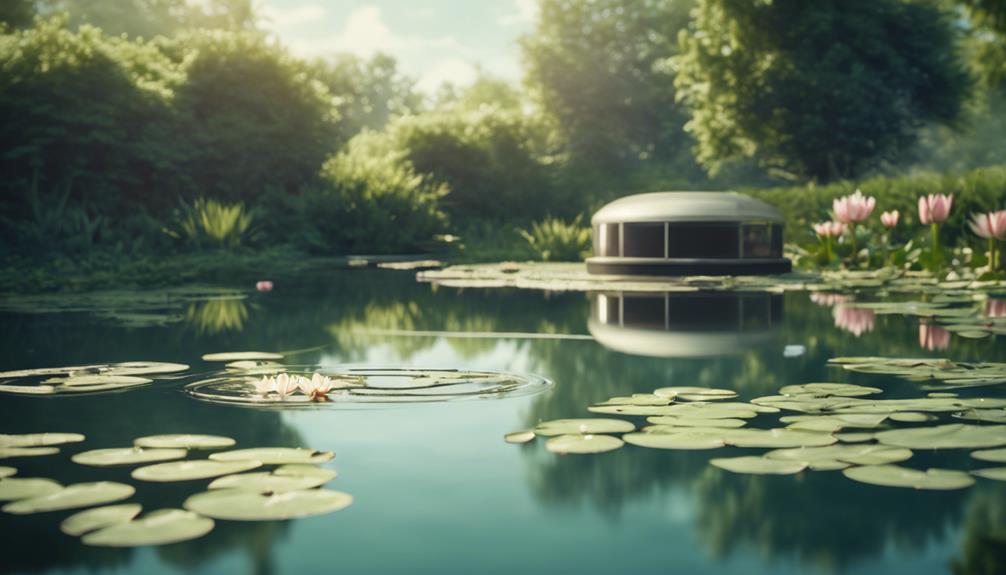You can effectively prevent algae growth in your pond by targeting the root causes of this problem. Limit excess nutrient entry by avoiding grass clippings, leaves, and fertilizer, and planting beneficial vegetation around the pond's edges. Balance nutrient levels naturally by reducing phosphorus and using biological augmentation methods. Implement a regular maintenance routine, monitor water quality, and introduce algae-grazing fish or other organisms. Use natural treatments like lanthanum-modified clay and alum, and employ aeration systems to improve water circulation. By taking these steps, you'll be well on your way to maintaining a balanced ecosystem and preventing algae growth; discover more strategies to keep your pond thriving.
Table of Contents
Key Takeaways
- Preventing excess nutrients from entering the pond is crucial, as it reduces the risk of algae growth and maintains a balanced ecosystem.
- Planting beneficial vegetation around the pond's edges helps absorb excess nutrients, stabilize the bank, and reduce erosion areas.
- Reducing phosphorus levels through methods like biological augmentation and lanthanum-modified clay prevents excess nutrient buildup and algae growth.
- Implementing a regular maintenance routine, including water quality monitoring and beneficial bacteria introduction, helps maintain a balanced ecosystem.
- Combining natural treatments, such as aquatic plants and beneficial bacteria, with regular monitoring and maintenance can effectively stop algae growth in ponds.
Limit Excess Nutrient Entry
To prevent algae growth, you must limit the entry of excess nutrients into your pond by controlling the amount of organic debris that reaches the water.
This means avoiding grass clippings, leaves, fertilizer, and other nutrient-loaded materials from entering the waterbody. By doing so, you'll reduce the risk of excess nutrients fueling algae growth.
Limiting mowing around the edges of your lake or pond is also vital, as it helps establish a protective vegetative buffer that reduces erosion areas and keeps nutrients from entering the water.
Planting beneficial vegetation in and around the edges of your pond can also help.
These plants stabilize the bank, reduce erosion areas, and absorb excess nutrients that could contribute to algae growth.
Aquatic plants like pickerelweed, sedges, and rushes are excellent choices for shallow areas within your pond, as they not only add beauty but also provide nutrient absorption.
By taking these steps, you'll be able to prevent algae growth and maintain a healthy, thriving ecosystem.
Balance Nutrient Levels Naturally
As you work to balance nutrient levels naturally, you'll want to focus on reducing phosphorus levels, which fuel algae growth.
You can explore various phosphorus reduction methods, such as biological augmentation and lanthanum-modified clay, to prevent excess nutrient buildup.
Phosphorus Reduction Methods
Frequently, pond owners find that phosphorus reduction methods are essential to balance nutrient levels naturally and prevent algae growth.
As you work to maintain a healthy ecosystem, it's vital to address phosphorus levels, which can contribute to excessive algae growth.
One effective approach is to use lanthanum-modified clay, which can permanently remove phosphorus from the water column and lock it away in the pond's muck.
Biological augmentation is another strategy, as it helps maintain a balanced ecosystem and reduces nutrient accumulation.
Alum can also be used to remove phosphorus from larger waterbodies, improving water clarity.
Additionally, nutrient remediation solutions can help eliminate excess phosphorus, preventing algae blooms.
Perhaps most appealing, you can harness the power of beneficial bacteria to consume excess nutrients, promoting a balanced ecosystem.
Products like Natures Defense and Muck Defense, safe for ponds with fish and wildlife, can aid in phosphorus reduction.
Natural Nutrient Absorption
You can further balance nutrient levels naturally by harnessing the power of aquatic plants, which absorb excess nutrients, helping to prevent algae growth in your pond. Adding aquatic plants such as pickerelweed, sedges, and rushes can add beauty to your pond while providing natural nutrient absorption. These plants are particularly effective at absorbing phosphorus, the primary limiting nutrient in algae growth.
| Plant | Nutrient Absorption | Additional Benefits |
|---|---|---|
| Pickerelweed | High phosphorus absorption | Provides habitat for aquatic life |
| Sedges | Moderate phosphorus absorption | Helps maintain water clarity |
| Rushes | Low phosphorus absorption | Adds aesthetic value to pond |
In addition to aquatic plants, biological filters can also aid in nutrient absorption. By introducing beneficial microorganisms, biological filters can break down excess nutrients, reducing the likelihood of algae growth. Moreover, nutrient remediation solutions can be used to remove phosphorus from the waterbody, preventing algae blooms. By incorporating these natural methods, you can maintain a healthy and balanced ecosystem in your pond, preventing algae growth and promoting a thriving aquatic environment.
Prevent Excess Nutrient Buildup
By taking proactive steps to prevent excess nutrients from entering your pond, you can substantially reduce the risk of algae growth and maintain a balanced ecosystem.
Excess nutrients, such as phosphorus, can fuel algae growth when combined with sunlight. To prevent this, focus on limiting nutrient sources like grass clippings, leaves, and fertilizer from entering the water.
Planting beneficial vegetation in and around the pond's edges can help absorb excess nutrients and stabilize the bank.
Biological augmentation can also aid in maintaining a healthy water ecosystem, reducing the accumulation of nutrients and organic sludge.
Additionally, lanthanum-modified clay can permanently remove phosphorus from the water column, locking it in the pond's sediment and effectively preventing algae growth.
By balancing nutrient levels naturally, you can create an environment where algae struggle to thrive.
Use Biological Augmentation Effectively

When you use biological augmentation effectively, you're taking a vital step towards stopping algae growth in your pond.
By balancing nutrient levels, you'll create an environment where microbe dosing benefits can thrive, and natural pond remediation can occur.
Now, let's explore how to make the most of this approach and maintain a healthy, algae-free pond.
Balance Nutrient Levels
One key approach to effectively balance nutrient levels and prevent algae growth is to utilize biological augmentation, which involves introducing naturally occurring microbes and enzymes that aid in maintaining healthy water ecosystems.
By dosing these micro-organisms, you can boost the natural populations in your pond, reducing the accumulation of nutrients and organic sludge. This, in turn, removes the primary food source for algae blooms, promoting healthy water quality.
To further balance nutrient levels, you can employ methods that target phosphorus, a key contributor to algae growth.
Lanthanum-modified clay, for instance, can permanently remove phosphorus from the water column and lock it in the muck on the pond's bottom.
Alum is another effective method for removing phosphorus from larger waterbodies, improving water clarity in the process.
By combining these approaches, you can create an environment that's less conducive to algae blooms.
Microbe Dosing Benefits
You can effectively harness the power of microbe dosing to improve pond water quality by introducing beneficial bacteria and enzymes that augment the natural populations of microbes in your pond.
This biological augmentation method boosts the natural populations of microbes, helping to reduce the accumulation of nutrients and organic sludge.
By doing so, microbe dosing removes the primary food source for algae blooms, promoting healthy water quality and preventing algae growth.
As you dosed your pond with beneficial microorganisms, you're supporting a balanced ecosystem.
These microbes break down organic matter, reducing sludge buildup and maintaining a healthy balance.
When used in conjunction with other best management practices, microbe dosing is a natural and effective way to balance nutrient levels in your pond.
By introducing these beneficial bacteria and enzymes, you're taking a vital step towards stopping algae growth and maintaining a thriving ecosystem.
With microbe dosing, you can rest assured that your pond is on its way to becoming a haven of healthy water and balanced life.
Natural Pond Remediation
By leveraging biological augmentation, pond owners can implement a natural remediation strategy that harnesses the power of beneficial microorganisms to restore and maintain a balanced ecosystem. This approach is particularly effective in controlling algae growth, as it tackles the root cause of the problem – excess nutrients in the water.
Biological augmentation can benefit your pond in three ways:
- Boosts natural populations: By dosing naturally-occurring micro-organisms, you're increasing the number of beneficial microbes in your pond, which helps reduce nutrient accumulation and organic sludge.
- Balances nutrient levels: Beneficial bacteria consume excess nutrients, preventing algae blooms and maintaining healthy water quality.
- Promotes a balanced ecosystem: Biological augmentation aids in maintaining a balanced ecosystem, removing the primary food source for algae growth and promoting clean, healthy water.
Install and Run Aeration Systems
Installing an aeration system is a pivotal step in maintaining water quality and preventing the accumulation of nutrients that can lead to excessive algae growth.
By running an aeration system, you'll increase diffused oxygen in the water, which supports and encourages the growth of beneficial aerobic bacteria. These bacteria break down organic matter and consume excess nutrients, helping to balance and improve water quality.
With increased oxygen levels, you'll reduce the likelihood of anaerobic conditions that can contribute to algae growth. Additionally, a well-designed aeration system will circulate water, reducing stagnation and preventing the formation of 'dead zones' where algae can thrive.
To confirm your aeration system operates effectively, regular maintenance is essential. This will provide the necessary oxygen levels to prevent algae growth.
Maintain Clean Water Proactively

Proactive water maintenance involves adopting a holistic approach that focuses on balance and prevention, rather than merely treating algae growth after it occurs.
By taking proactive steps, you can control algae growth and maintain clean water in your pond.
Improve water quality: Limit excess nutrients from entering the water by avoiding grass clippings, leaves, fertilizer, and other nutrient-loaded organic debris from getting into the waterbody.
Encourage beneficial bacteria: Aeration systems increase diffused oxygen in the water, which supports and encourages the growth of beneficial aerobic bacteria that break down organic matter and consume excess nutrients.
Use natural and safe techniques: Proactive management involves using techniques and products that are natural and completely safe for use in the aquatic environment, limiting reliance on pond algae treatments using algaecides.
Prevent Algae Blooms Naturally
To prevent algae blooms naturally, you'll want to focus on limiting nutrient inflow and balancing your pond's ecosystem.
By doing so, you'll create an environment that's less conducive to algae growth.
Limit Nutrient Inflow
By taking steps to prevent nutrient-rich materials from entering your pond, you can substantially reduce the likelihood of algae blooms. Excess nutrients in the waterbody can lead to rapid algae growth, which can have devastating effects on the ecosystem.
To limit nutrient inflow, consider avoiding nutrient-loaded debris such as grass clippings, leaves, fertilizer, and other organic matter that can enter the waterbody through runoff or direct entry. Make sure to dispose of these materials properly to prevent them from reaching your pond.
Establishing a protective vegetative buffer around your pond helps create a buffer zone that reduces erosion areas and keeps nutrients from entering the waterbody. This buffer zone can also be used to plant beneficial vegetation that absorbs excess nutrients.
Planting nutrient-absorbing vegetation such as aquatic plants like pickerelweed, sedges, and rushes not only adds beauty to your pond but also provides nutrient absorption, helping to maintain a balanced ecosystem.
Balance Pond Ecosystem
You can maintain a healthy pond ecosystem by introducing beneficial microorganisms that outcompete algae for available nutrients, thereby preventing blooms naturally.
These microorganisms, such as bacteria and enzymes, break down organic matter and consume excess nutrients, leaving nothing for algae to feed on.
This approach not only prevents algae problems but also improves the overall water quality of your pond water.
By achieving a balance pond ecosystem, you'll create a thriving environment for aquatic plants and animals to flourish.
In water gardens, a balanced ecosystem is vital to prevent the growth of unsightly algae.
When you introduce beneficial microorganisms, you'll notice a significant reduction in algae blooms, resulting in clearer and healthier pond water.
This natural approach to preventing algae blooms isn't only effective but also environmentally friendly.
By balancing your pond ecosystem, you'll enjoy a beautiful and sustainable water feature that requires minimal maintenance.
Use Chemical-Free Algae Treatments

Chemical-free algae treatments offer a safer, more environmentally friendly alternative to traditional methods, utilizing natural processes and substances to control algae growth in ponds. As you explore these alternatives, you'll find that they're not only better for the environment but also for the aquatic life in your pond.
Barley products are safe for ponds with fish and wildlife, and can remove algae and keep ponds clean and clear for up to six months. These products come in the form of barley straw, extract, and pellets.
Beneficial bacteria consume nutrients and organic material, preventing algae blooms. You can find them in products like Natures Defense and Muck Defense.
Aquatic plants absorb excess nutrients, limiting algae growth. Plus, shading 40-60% of the pond's surface area with plants blocks sunlight, preventing algae growth.
These treatments work in harmony with your pond's ecosystem, creating a balanced environment that discourages string algae growth. By choosing chemical-free treatments, you're taking a proactive step towards maintaining a healthy, thriving pond that supports a diverse range of aquatic life.
Implement Effective Pond Maintenance
To guarantee the long-term health and clarity of your pond, implementing a regular maintenance routine is vital to prevent algae growth and maintain a balanced ecosystem.
As you start your spring pond care, focus on creating an annual program that balances and prevents algae through water quality improvements.
Regularly monitor and maintain your pond's water conditions, including pH, ammonia, nitrite, and nitrate levels, to prevent algae blooms.
Performing weekly water changes of 10-15% will remove excess nutrients and prevent algae growth.
Cleaning your pond regularly, including removing debris and decaying matter, prevents the buildup of nutrients that can contribute to algae growth.
Additionally, maintaining a balanced ecosystem by introducing beneficial bacteria, aquatic plants, and other natural elements will help prevent algae growth and maintain water quality.
Be mindful of water temperatures, as they can affect suspended algae growth.
Control Algal Blooms in Ponds

By understanding the underlying factors that trigger algal blooms, pond owners can take targeted measures to control their growth and prevent devastating consequences. Harmful algal blooms can deplete oxygen levels, release toxins, and even harm aquatic life.
To prevent these issues, you can implement the following strategies:
Reduce Excessive Nutrients: Limit the amount of phosphorus and nitrogen entering your pond, as these nutrients fuel algae growth. Implement measures to reduce runoff from surrounding areas and avoid over-fertilizing nearby plants.
Use UV Clarifiers: Ultraviolet clarifiers can help eliminate algae cells by exposing them to UV light, which damages their DNA and prevents reproduction. This method is especially effective against green water algae.
Maintain Proper Water Circulation: Guarantee your pond has adequate water circulation to prevent stagnant areas where algae can thrive. This can be achieved through the use of pumps, aerators, or water features.
Monitor Water Quality Regularly
Regular water quality monitoring is crucial for identifying potential issues before they escalate into full-blown algae blooms, and you should prioritize it as a key component of your pond maintenance routine. By regularly checking your pond's water quality, you can detect nutrient imbalances, pH level fluctuations, and oxygen level changes that can contribute to algae growth. This proactive approach enables you to take corrective action before algae blooms form.
| Parameter | Importance |
|---|---|
| Ammonia, Nitrite, and Nitrate levels | Indicates excess nutrients fueling algae growth |
| pH levels | Affects algae growth and overall ecosystem balance |
| Dissolved Oxygen levels | Influences algae growth and aquatic life survival |
| Water Temperature | Impacts algae growth rates and ecosystem dynamics |
| Water Clarity and Color | Indicates early signs of algae blooms |
Frequently Asked Questions
How Do I Stop Algae From Growing in My Pond?
To prevent algae overgrowth in your pond, you'll want to focus on improving water circulation through pond aeration, implementing algae prevention strategies, and committing to regular maintenance, ensuring a balanced ecosystem that supports aquatic life.
What Stops Algae From Growing in Water?
As you gaze into the serene water, imagine a delicate balance of elements. You find that it's not just magic that stops algae from growing in water – it's the harmony of water chemistry, UV radiation, oxygen levels, and nutrient levels that keep it in check.
How to Clear Green Pond Water Naturally?
You can clear green pond water naturally by introducing natural clarifiers like aquatic plants, implementing water aeration, or using UV treatment to reduce algae growth, while beneficial bacteria break down organic matter.
What Are the Best Pond Plants for Algae Control?
You're literally drowning in a sea of algae control options! Focus on incorporating Water Lilies for shade, Oxygenating Plants for nutrient uptake, Floating Islands for habitat diversity, and Aquatic Grasses for erosion control – a holistic approach to a balanced ecosystem.
Conclusion
By implementing these 10 strategies, you'll be well on your way to taming the 'green monster' that's been plaguing your pond.
As nutrient levels dwindle, your water's clarity will begin to shine like a polished gem.
With each passing day, the delicate balance of your ecosystem will be restored, and your pond will transform into a serene oasis, teeming with life and vigor.

